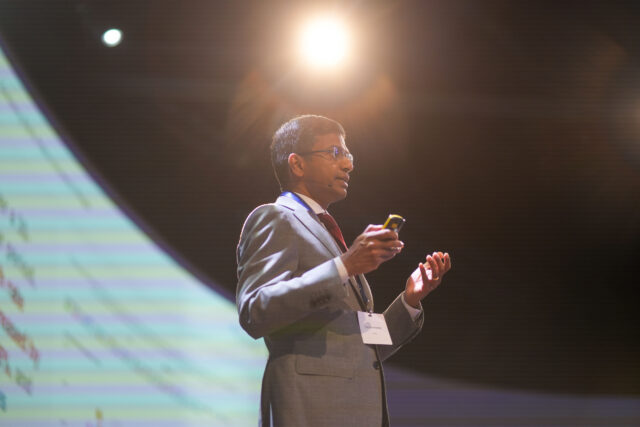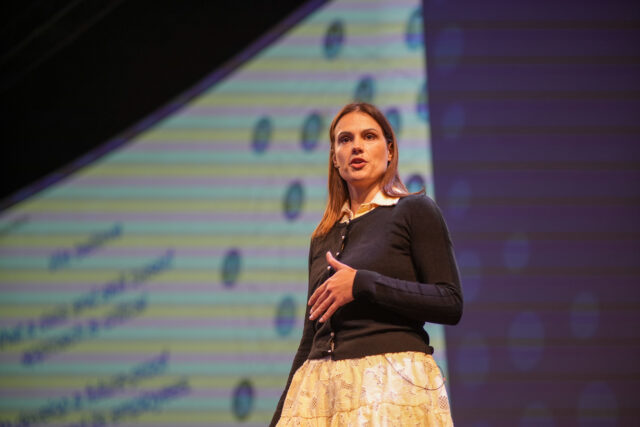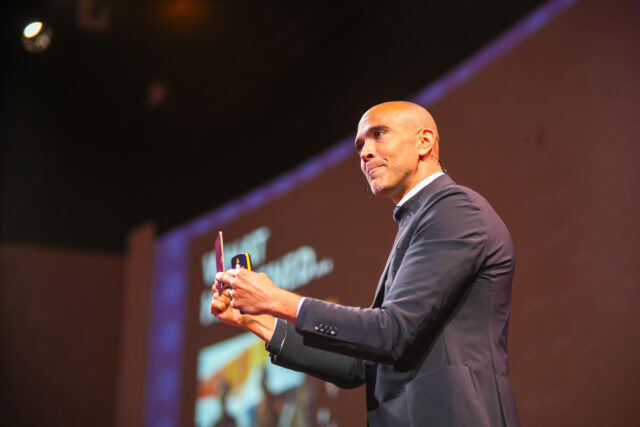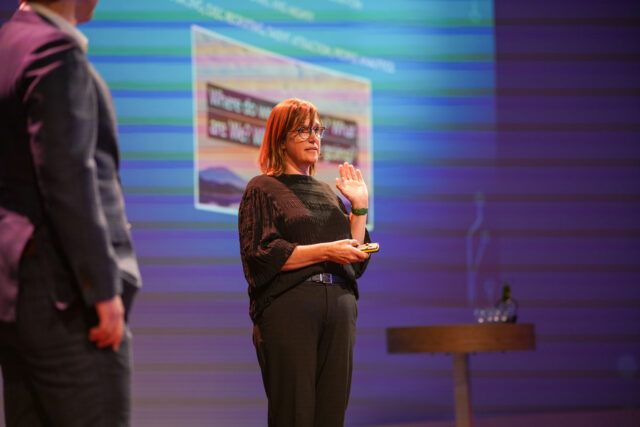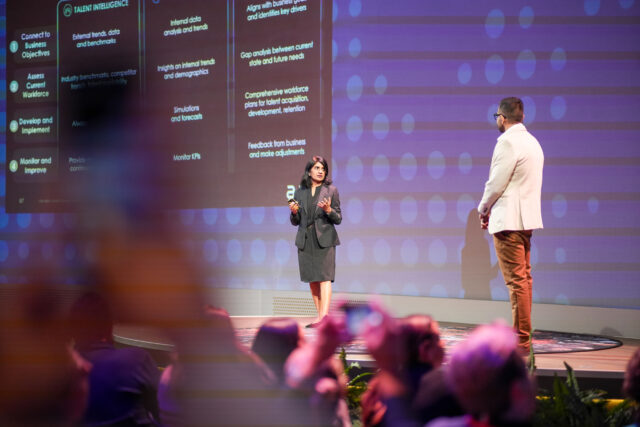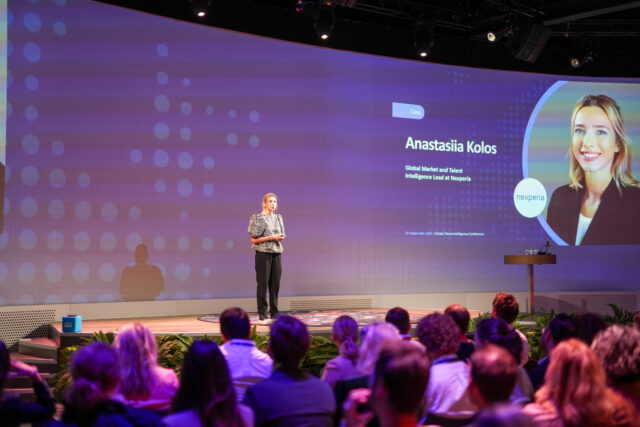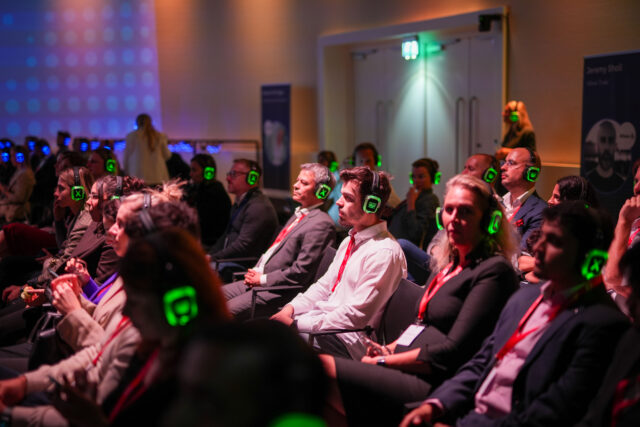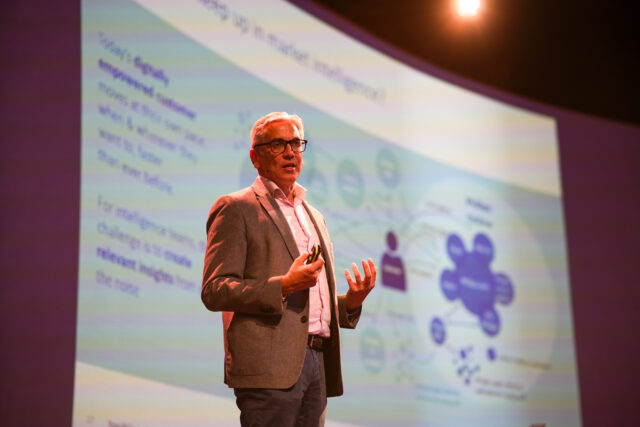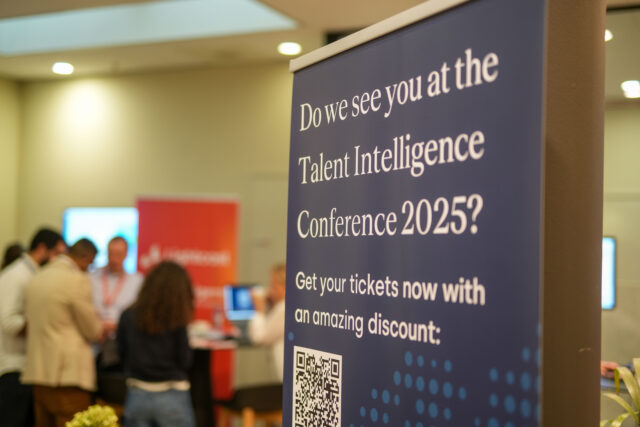
It was a packed program that the organizers of the second edition of the Global Talent Intelligence Conference had put together. Two full days with the crème de la crème of this rapidly growing field from around the world, and for a sold-out audience at the headquarters of HeadFirst in Hoofddorp. There was so much content that it was sometimes difficult to discern a common thread. However, if we must highlight one, it would be: the importance of storytelling and stakeholder management. In other words, how to turn all that interesting data into a compelling narrative. And in doing so, achieve success.
This started right from the first day, when the host, HeadFirst CEO Marion van Happen, said she expected a major disruption in the next 12 months, as more companies discover the possibilities of A.I. for their HR policies and learn to improve their productivity. She immediately shared some inspirational words with the attendees: “Being inspired is great. But putting it into practice, that’s truly awesome. It’s not just about gathering data, but also about turning it into actionable strategies.”
Jack Kennedy, senior economist at Indeed, followed up with a macro-level discussion about the current situation in the labor market and the broader economy. He noted that labor market mobility has significantly slowed since the pandemic, although fortunately, the number of layoffs remains low. Interestingly, while job vacancies in the UK have dropped significantly compared to pre-pandemic levels, they have risen by more than 60% in Italy. And the good news, according to Kennedy, is that salary transparency is on the rise. However, Germany still lags far behind in this area.
‘More software needed, not less’
The audience was gradually being prepared for the core Talent Intelligence section of the conference. It began with Draup CEO Vijay Swaminathan, who once again highlighted the wonders of A.I., including the Dutch initiative GPT-NL, which is set to launch next year. “This is truly Europe’s moment to step up and make organizations future-ready,” said the CEO of the international Talent Intelligence platform.
Is this a threat to our employment as A.I. increasingly renders human work unnecessary? Absolutely not, according to Swaminathan. “A.I. is much more than task automation. It’s also about control, certainty, transparency, vigilance, and choice. With Large Language Models, humans can perform better. Lawyers and doctors who use A.I. perform significantly better than their peers who don’t. A.I. turns people into hyper-efficient individuals, making human work even more valuable. The world needs more software and automation, not less.”
Now… the practical side
Last year, it was still quite rare to find compelling real-life case studies at the conference, as the field was still so new. This year, however, more companies were able to showcase what Talent Intelligence can deliver in practice. For instance, Sarah Assinger, on behalf of Spain’s Telefónica, together with Stephan Menge from Textkernel, spoke about skills as the currency of the future and how data helps the company identify connections between these skills. “Millions of words that need to be brought together so that everyone speaks the same language,” as Assinger explained.
At Telefónica, they mapped out who will retire in the coming years and what skills gaps this will create. Then, using market data, they looked at the availability of those skills to determine whether they should be sourced externally or developed internally. “Make or buy?” This is how Talent Intelligence can be applied to increasingly strategic questions, Menge added. However, Assinger emphasized that internal communication is crucial. “Even if we have magic insights, it’s not easy to sell them internally. You really have to show that you understand the business.”
The first series of breakouts
After the keynote by Joost Heins (Randstad), it was time for the first series of breakouts. A fun twist: to allow two breakout sessions to take place in the same room simultaneously, they introduced the concept of a silent disco. Half of the audience wore green-lit headphones, while the other half had blue-lit ones. They could tune into the presentation by Lisa Simon (Revelio Labs) and Nick Dowler (NVIDIA), who discussed how A.I. can boost workforce productivity.
To gain a clear understanding of this, they dissected various jobs and role descriptions into tasks. Then they asked ChatGPT which tasks it could perform better. “But ChatGPT is a man, and a bit arrogant,” joked Simon. “Luckily, we could filter that out, allowing us to get a good overview of tasks, which we then checked with the workforce.” The analysis revealed, for instance, that account managers and marketing managers don’t have much to fear from A.I.; their roles will likely remain. However, recruiters? They use A.I. relatively little, but have much more to fear from it, Simon explained.
The rise of A.I., she said, encourages us to think less in terms of jobs and more in terms of individual tasks that add up to a role. “I don’t think A.I. will replace jobs, but it will reconfigure them. Work isn’t disappearing; we just need to be open to regrouping tasks. Automation and augmentation are our focus.” Dowler added, “My hook is: 85% of the jobs that will exist five years from now don’t exist today. Yes, that’s scary. But everything is scary. Don’t be afraid, jobs will still exist—just not in the same way they do now.”
5.7 million applicants per year
Later in the afternoon, it was time for Irmgard Naudin Ten Cate, who, as a global talent attraction and acquisition leader at EY, spoke about how the company hires around 100,000 new employees from 5.7 million applicants each year and how it strives to maintain a high-level candidate experience for everyone. Something she seems to excel at: where 10 years ago, only 75% of candidates said they had a good experience with the company, that figure has now risen to 93%.
Under the slogan ‘I love surveys‘, EY has also added surveys for hiring managers in recent years. Among other things, these show that 88% of them believe the recruiters provide an exceptional experience. ‘There’s still work to do; I want that number in the 90s,’ said Naudin Ten Cate, who also focused attention on EYQ, the A.I. platform designed to support EY employees in all their tasks. But human attention remains important, she emphasized. ‘The people they meet remain the key factor for candidates deciding whether or not to join us.’
Wizards and villains
Kim Bryan, Head of Global Insights & Talent Intelligence at AMS, also focused on practical matters, but presented them in the form of a fairy tale. For a Talent Intelligence professional, translating data into stories is key, she said. ‘Comparing apples with apples and avoiding the poisoned apple,’ as she put it. In a narrative filled with kings, princes on white horses, quests, wizards, and villains, she urged the audience to focus on data quality and data literacy. Only with that, she argued, can dragons be slain.
But once that is achieved, the ‘And they lived happily ever after’ can begin, Bryan said. Her company is now fairly adept at predicting how many applicants a particular job vacancy will receive and what the time-to-hire will be in each case. ‘What does it take? Time, money, and patience. Don’t give up, because it’s all worth it,’ she shared. ‘Our role as Talent Intelligence professionals is not to ride off into the sunset on a magic carpet but to advance this field.’
The opposite of a fairy tale
Speaking of storytelling… And then, not a fairy tale but rather the opposite. After the keynote by Ben Zweig, the last word of the day was given to IT engineer Joseph Oubelkas, whose previously flawless life turned into a nightmare on Thursday, December 23, 2004. At the age of 23, he was arrested in Morocco for drug smuggling and eventually – without a shred of evidence – sentenced to a 10-year prison sentence, an ordeal he chronicled in the book 400 Letters from My Mother.
The audience listened in rapt silence to the story of the man who kept his spirits up during his 1,637 days in prison by focusing on the things he could control, however few they might be, and by not being distracted by what he couldn’t change. Throughout it all, he felt supported by the letters from his mother, which kept him going during those years. A beautiful conclusion: ‘If A is 1, B is 2, and so on, then KNOWLEDGE equals 96, HARD WORK equals 98, and ATTITUDE equals 100!’ Do the math… It was a performance that was still being discussed during the evening program.
‘GPS for talent’
On the second day of the two-day conference, the effects of the previous evening’s program were still visible. But Kristine Mayle, Global Talent Intelligence & Insights at Vertex Pharmaceuticals, managed to inspire her audience early in the morning with a story about how she organizes a news feed for the company’s recruiters. The pharma company, which may not be widely known but now employs 5,000 people, grows by about 1,000 employees annually and currently generates around $10 billion in revenue each year.
As a Ph.D. bioengineer, she was the first at the company to focus on Talent Intelligence 3.5 years ago. But the role has since grown significantly, she explained. Thanks to roadshows, where she constantly explains that her role is like a ‘GPS for talent’, guiding recruiters using competitor analyses, talent trends, data, and tools. Her message? ‘Surround yourself with curious T-shaped people. And tell your story to as many people as possible, you never know who might be a hidden champion.’
Picnic, the ‘modern milkman’
A company that no longer needs to tell its story as much, and is no longer quite as hidden as a champion, is Picnic. The ‘modern milkman’, as recruitment lead Jeroen Klerkx calls it, now has around 3,000 electric vehicles driving around various cities, from Amersfoort to Lille. And nearly all of the recruitment for the approximately 18,000 employees and 350,000 applicants each year is handled in-house, Klerkx explained. ‘We use less than 1% from employment agencies.’
Data and technology are the building blocks of the company, he further explained. From the employee app to the technology used to improve drivers’ skills, but also in recruitment, where each applicant can select a call slot within an hour. However, the human touch remains important, and data and humanity often come together, he said. ‘For instance, I have a full-time UX expert on my team who continuously interviews applicants about their application experience. From there, we strive to improve the human aspect of our recruitment every time.’
Predicting as a challenge
If you think Picnic is a fast-growing organization, you haven’t encountered Nvidia yet, now one of the world’s largest companies by market value. Global Talent Intelligence & Attraction Manager Meta McKinney explained how the company’s growth parallels the growth of the Talent Intelligence department. She monitors internal mobility, engagement, and satisfaction of both employees and applicants. This yields many insights, but the predictive aspect of all that data remains a challenge for her.
Interestingly, she said, she has more success with these insights outside the HR department than within it. And: ‘outside HR, it’s much easier to get funding for these kinds of data projects. Inside HR, it’s always tough.’ Talent Intelligence is no longer a purely HR topic, she argued. ‘It’s a combination of HR, data science, and IT. So you need a cross-functional team.’ And, very important: senior leadership support. ‘Look at their problems. And find solutions for them. Otherwise, it will be difficult to build enthusiasm and scale quickly.’
The Story of the Elephant
From another large company, the software supplier Amdocs, which now has 30,000 employees, we learned how success in Talent Intelligence depends on connecting the dots. Meghna Gupta and Kumar Vaibhav shared the story of an elephant in a dark room. The first person to enter the room felt the trunk and thought they were dealing with a snake. The next person felt its ears and thought it was a leaf. Another felt its leg and thought it was a tree trunk. In the end, no one sensed the elephant. And according to them, that’s exactly the challenge in their field.
‘If you work in silos, you’ll never see the elephant,’ said Gupta (left). Therefore, Amdocs’ Talent Intelligence department, with a $5 billion revenue, focuses on creating synergy with other internal departments. Their analysis revealed a direct correlation between unwanted turnover and the number of external job vacancies. From this, they developed a predictive model that now estimates when someone shows a flight risk and whether it’s worth intervening. ‘Low turnover can also be a signal of little innovation,’ Vaibhav noted.
What is your serviceable obtainable market?
Anastasiia Kolos, speaking on behalf of Nexperia, discussed what Talent Intelligence can learn from sales and marketing. According to her, this involves thinking in funnels, but also understanding your serviceable obtainable market. ‘This aligns well with how we talk about talent acquisition in our field. Sometimes, we talk about all the software engineers in the world, but what’s more interesting is: which part of the market fits your needs, and what can you realistically access?’ According to her, it’s essential to map out this segment of the market.
Another lesson is thinking from the customer’s perspective. ‘In this field, we are often real data nerds. But we sometimes forget about our customers. Let’s look more at what frustrates them and how we can help. Are we doing enough of what the customer wants and needs? Do we know their pain points? And are we providing the right solutions?’
(No) Amazon on Instagram and TikTok
Good questions. But some things also happen more or less by chance, as we learned from Lucy Scott. Since graduating six years ago, she has been working as a recruiter at Amazon, but over time she noticed that the company was increasingly failing to engage Gen Z. Not surprising, when you consider that Amazon was entirely absent as an employer on TikTok and Instagram. ‘When we wanted to reach 21-year-olds, we were still cold-calling them out of the blue. But that didn’t work at all,’ she explained. ‘They just wouldn’t pick up.’
In addition to her work as a recruiter, she then started a research project, sending a survey to 5,000 graduates and writing a paper on the results. This brought her into contact for the first time with Amazon’s already established Talent Intelligence department, led by Toby Culshaw, where she had the opportunity to work for three months. Upon returning to her department, she applied the lessons learned and managed to increase the number of applications in Germany by 240%, and website traffic by 632%.
Her message? Don’t start at the top with directors; start with the recruiters. ‘That’s where the problems are. If you can help them with data-driven insights, you can quickly make recruitment 100% better. Remember: without data, you’re just someone with an opinion. And your opinion is no more valid than that of any hiring manager. But once you have the data, your work becomes much more valuable. And don’t forget: we’re called recruitment consultants for a reason. We need to live up to that role and show that Talent Intelligence makes the best recruiters.’
Insights into the extended workforce
More large organizations took the stage… Maarten Hansson and Ralf Zoetekouw, representing Workforce Insights, presented a case on the company Novartis, which has 78,000 internal employees and 44,000 external workers. But would you think that such a company has a complete overview of all those people? You might be sorely mistaken, they said. Over the past year, they have mapped out the extended workforce as much as possible from the perspectives of cost, talent, and risk. ‘Do you know where everyone is? And do you know what everyone is doing? Because the longer a freelancer stays, the bigger the risks become.’
Those risks can include security issues, like when departed external workers still have access to company accounts or retain a company laptop. But there are also financial risks, such as when you pay external workers a Swiss salary while they work from India, or intermediaries charge excessive margins. Even ChatGPT can help with this, Zoetekouw explained. ‘We used it to create a good prompt to gain insight. It wasn’t 100% accurate, but it was 95% accurate. And that was often enough to determine whether to hire internally or externally.’
What? So what? And: now what?
For Stuart McGown, the next keynote speaker from Philips, Talent Intelligence revolves around three questions. What? In other words, what is happening? So what? What is the relevance? And finally, now what? What should we do about it? ‘Around 70% of the time in our field is spent on the what? and only 30% on the other two. That’s a bit out of balance, in my opinion.’
He also returned to the theme of the day: interestingly, it’s not so much about A.I., but about topics like stakeholder management, persuasion, storytelling, and advisory skills. ‘I’ve too often seen people working on their data until just a few hours before their presentation,’ McGown observed. ‘But I believe they should focus on the end of the value chain. As talent intelligence experts, we are also needed to translate the data, to advance the organization in terms of data literacy, and not to justify decisions that have already been made.’
Performance doesn’t follow a normal distribution
And so we arrived at the final speaker of the two packed days: the always impactful Rina Joosten-Rabou, who, on behalf of her company Pera, provided a great summary of the conference by stating that Talent Intelligence could well become the driving force behind increased labor productivity in the coming years. She then illustrated this with some fascinating, counterintuitive research findings, such as the fact that managers aren’t very good at evaluating employee performance. And that performance among employees doesn’t follow a normal distribution but rather a Power Law distribution.
How can we overcome these counterintuitive findings? By using A.I. to compensate for our bias, she explained. ‘A.I. can detect patterns infinitely faster than humans and correct the human bias. We need to change our mindset. We can no longer identify talent the way we always have if we want to improve our organization’s performance. That’s my main message: we’re not promoting the best people because we overestimate our ability to assess them correctly. If we manage to change that, big new things are possible.’
Conclusion: looking ahead to 2025
And with that, Joosten-Rabou beautifully brought it back to what this conference was all about: making better decisions regarding talent through data and research. And in doing so, helping organizations and economies move forward. Away from gut feelings, and towards the science of what truly works and what doesn’t. And it turns out that this is not only an inspiring journey full of great stories but also a very enjoyable one, as evidenced by a conference like this, where all the professionals come together. So, looking forward to the 2025 edition?
Read also
How NVIDIA’s Talent Intelligence approach helped fuel its trillion-dollar rise




